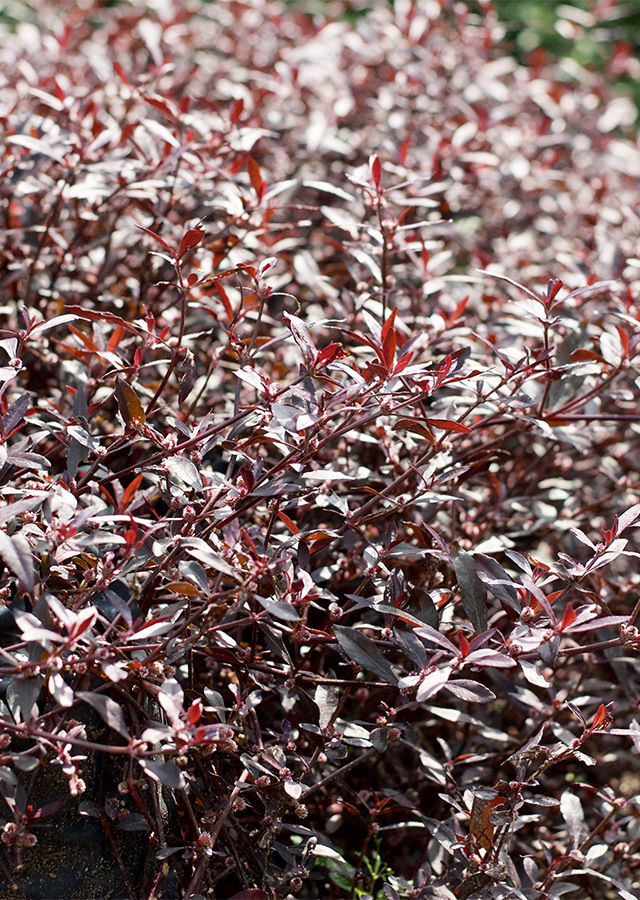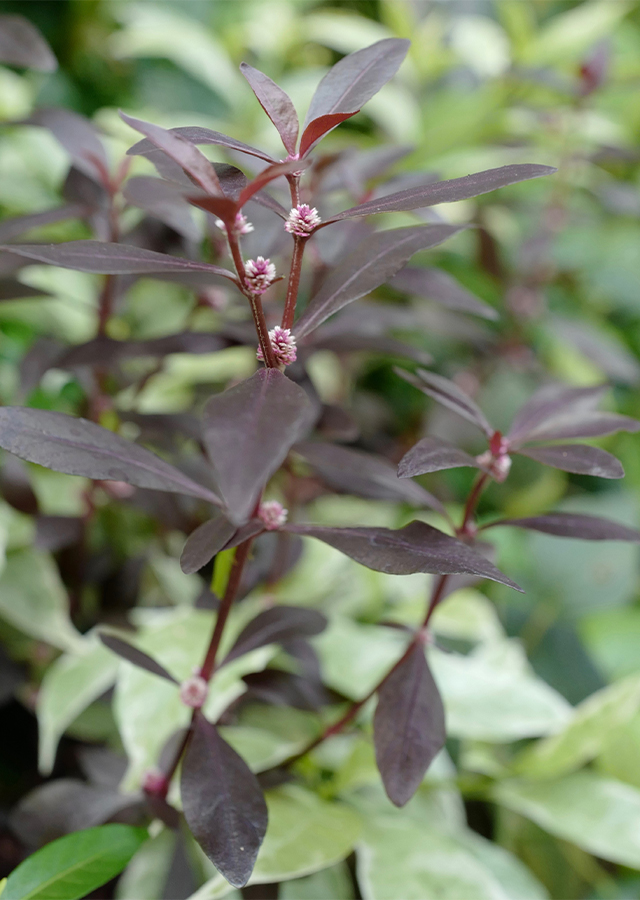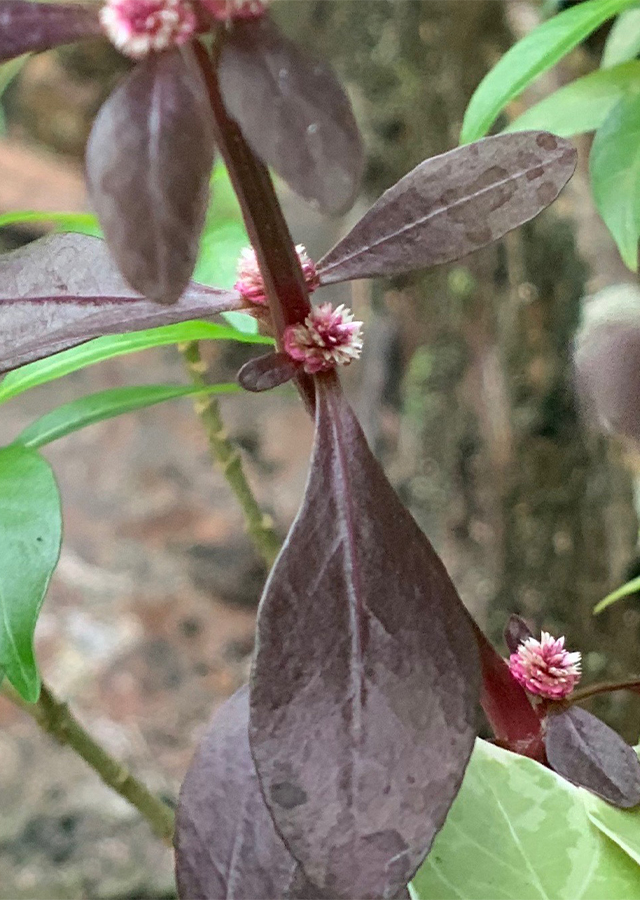Sessile joyweed
Alternanthera sessilis (L.) R.Br. ex DC.
Amaranthaceae
Location in our garden
Principal



Synonym
Achyranthes polygonoides (L.) Lam.
Achyranthes repens Elliott
Achyranthes sessilis (L.) Besser
Habitus
Herbaceous. Annual or perennial, 0.2-1 m high, strong taproots
Part Used
The Whole Plant
Growing Requirements
Full Sunshine
Need Shade
Habitat
Wetland
Riverbanks
Roadside
Grassland
Overview
Sessile joyweed possibly originates from tropical America, but it is now widespread in the tropics and subtropics of the world, including the whole of tropical Africa. The plant is often harvested from the wild for local use as food and medicine.
Vernacular Names
Bunga-bunga (Tagalog-Philippines), Lian zi cao (Chinese), Keremak (Malay), Brede chevrette (French), Honagonne soppu (Kannada), Colchon de nino (Spanish), Phakpet khaao (Thai), Khaix ped (Laos), Tsurunogeito (Japanese).
Agroecology
It is a very common plant of constant or periodically humid, open localities in roadsides, gardens, ditches, swamps, rice fields and tea plantations, on many types of soil, at up to 1,800 m altitudes. Succeeds in sun or moderate shade. Prefers a loamy, alkaline soil, but can succeed in a wide range of soils. It can be grown in moist to wet soil and in shallow water.
Morphology
- Stem - generally prostrate, creeping, often rooting at the nodes, sometimes floating or ascending at the tips, cylindrical and slightly hairy, with numerous, erect branches.
- Leaves -simple, opposite, shortly petiolate or sessile, broadly lanceolate or spatulate to almost linear, 0.6-5 cm long, and 0.3-1 cm wide.
- Inflorescences - dense, sessile, silvery-white clusters of compressed spikes in the leaf axils; perianth segments are equal in length, acute, 1.5-2.5 mm long with a short point.
- Fruits - indehiscent, a small, flattened, obcordate or obovate utricle, 2-2.5 mm long, enclosing the seed.
- Seeds - dark-brown to black, disc-shaped and shiny, about 0.8-1 mm in diameter.
Cultivation
It is propagated by seeds, division of underground stems, and nodal cuttings.
Chemical Constituents
Alkaloids, flavonoids, glycosides, terpenoids, anthraquinones, saponins, tannins, steroids, phenolic, sterol (stigmasterol, β-sitosterol).
Traditional Medicinal Uses
- Considered febrifugal, galactagogue, abortifacient.
- Its root can relieve inflamed wounds.
- Studies have shown antimicrobial, hepatoprotective, antioxidant, antidiabetic, hematinic, antipyretic, anti-inflammatory, antihyperlipidemic, phytoremediation, wound healing, nootropic, analgesic, antidepressant properties.
- A poultice of pounded fresh material is used to treat sprains, burns and eczema.
- The plant is used for carbuncles, erysipelas, as a wash for eyes, treating acne vulgaris, dyspepsia, liver problems.
- The decoction is used as a herbal remedy to treat wounds, flatulence, nausea, vomiting, cough, bronchitis, diarrhea, dysentery and diabetes.
- The leaves and shoots are boiled and drunk as an antihypertensive remedy.
- In West Tropical Africa, used as a poultice for boils.
- In Bangladesh, used for the treatment of severe pain.
- In Sri Lanka, used for cystitis, gonorrhea, snake bite. Also, used by mothers to increase the flow of milk.
- In Ghana, the salted decoction is used for hematemesis.
Part Used
Reference Sources
- CABI. (No date). Invasive Species Compendium. Alternanthera sessilis (sessile joyweed). https://www.cabi.org/isc/datasheet/4404. 20-02-2021.
- Fern, Ken. (2014). Useful Tropical Plants. Alternanthera sessilis. http://tropical.theferns.info/viewtropical.php?id=Alternanthera+sessilis. 20-02-2021.
- NCBI. (2018). Effects of Alternanthera sessilis on Liver Function in Carbon Tetra Chloride Induced Hepatotoxicity in Wister Rat Model. https://www.ncbi.nlm.nih.gov/pmc/articles/PMC5891458/. 20-02-2021.
- Pl@nt Use. (2016). Alternanthera sessilis (PROTA). https://uses.plantnet-project.org/en/Alternanthera_sessilis_(PROTA)#:~:text=Alternanthera%20sessilis%20is%20used%20in,and%20as%20a%20hair%20tonic. 20-02-2021.
- StuartXchange. (2016). Philippine Medicinal Plants. Bunga-bunga. http://www.stuartxchange.org/BungaBunga. 20-02-2021.
- Shehzad, A., Qayyum, A., Rehman, R., Nadeem, F. & Shehzad, M.R. (2018). Review of Bioactivity Guided Medicinal Uses and Therapeutic Potentials of Noxious Weed (Alternanthera sessilis). International Journal of Chemical and Biochemical Science 14:95-103.


